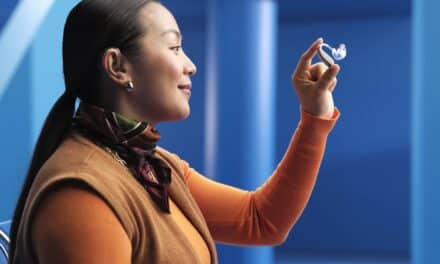A 13-month-old girl born without auditory nerves has received an auditory implant and has begun to hear and develop language functions. The child is reportedly the youngest patient to receive the auditory implant in the brain stem.
A team of ear, nose and throat specialists and neurosurgeons at the University Hospital of Navarra, led by doctors Manuel Manrique Rodriguez, specialist in ear, nose and throat surgery and Bartolome Bejarano Herruzo, specialist in pediatric neurosurgery, successfully completed the operation.
The medical centre had also successfully carried out a similar procedure on a girl of eight years. Throughout the world there have only been 38 brain stem implants in children under the age of 12.
The 13-month-old girl was born with a congenital illness characterized by the absence of the cochlear nerves which transmit to the brain the sound stimuli received by the auditory passage from the exterior. The rate of this disorder in the overall population is estimated at one in every 100,000 births
Surgical procedure
The absence of the cochlear or auditory nerve makes it impossible for the brain of those affected by this pathology to process the sound arriving from the exterior. This is why the treatment consists of directly stimulating the cochlear nuclei and the operation involves implanting electrodes onto these nuclei, in the brain stem of the brain, so that the complete auditory passage function is restored, enabling the electric impulses to arrive at the auditory cortex (of the brain), where meaning is conferred to the stimuli arriving.
Thus, the first phase of the operation, undertaken by the University Hospital team last October, involved implanting a plate of electrodes into the cochlear nuclei of the child. In order to place these electrodes there, access to the brain stem was effected by means of open cranial surgery of 3cm x 3 cm, thus enabling the brain surgeon to slightly retract the cerebellum to gain access to the exact spot where the implant had to be placed.
Once the electrodes’ system is installed and while the operation was taking place, stimulation tests on the device were undertaken in order to confirm the exact position where it had to be placed. One by one the 22 electrodes making up the implant were stimulated in order to check the auditory response. To this end, electroneurophysiological control was carried out in which Audiology and Neurophysiology teams took part. This intraoperational control of the stimulation of the electrodes and the auditory response obtained by each one of these enabled to reposition the implant ‘in situ’, during the operation, until getting the right spot.
Important activations
The operations with children carried out to date at the University Hospital have achieved highly favourable activations of the electrodes. Generally speaking, of the 22 electrodes implanted, the average activation without side effects is about 10. In both the operations they have undertaken they managed to stimulate 15 and 18 electrodes respectively.
During this operation a receiver-emitter was placed subcutaneously in the head of the patient and connected by a wire to the electrode device. This receiver is what obtains the sound of the other device located on the outside of the head of the child and which transmits sound to the interior by radio-frequency waves.
The external apparatus also has a microphone located behind the ear of the patient and which, in turn, is connected to a processor, required to modulate the characteristics of the sound signals received through the microphone.
The task of the internal receptor is to decode the signal received from the exterior and transform it into electrical impulses that arrive codified at each one of the electrodes. This is when the child receives a stimulus that propagates through the auditory passage to the brain, where the electrical impulses received are processed.
In the last phase of the procedure, carried out in January, the parameters of stimulation to be imprinted in the implanted device, namely intensity and velocity, were determined.
Auditiory verificatons
During the post-operational monitoring of this patient, it was observed that the child has begun to receive sounds and has even started to produce them. This is highly encouraging. The specialists have emphasised the importance of carrying out these operations at an early age when the capacity for learning is greater and the functional structure of the auditory centres is better prepared for receiving acoustic information.
Source: Medical News Today




